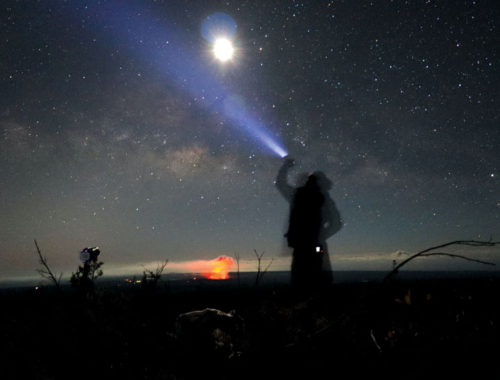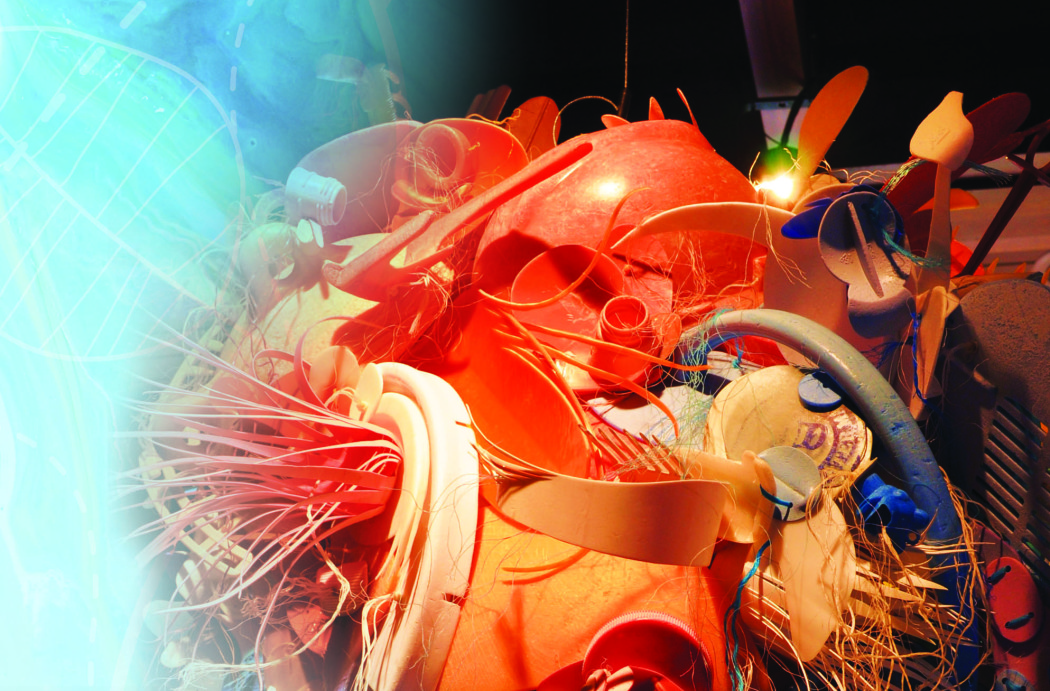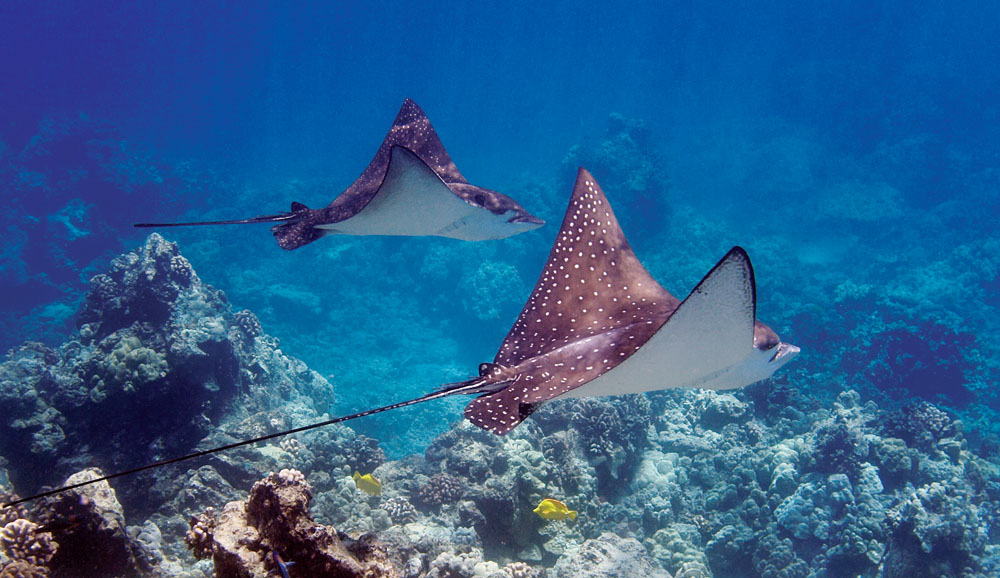
Fluid Ocean Portraits: Victoria McCormick’s Images Reflect a Trusting Relationship with Marine Creatures
 By Marya Mann
By Marya Mann
Dances with the Ocean
Heavenly light filters through the ocean surface into the underwater world, birthplace of life on Earth.
Fine art photographer Victoria McCormick slips into this liquid womb of coral reef and eagle rays, swimming in gentle accord with ancient creatures, bringing back some of the most dazzling images of marine life ever recorded.
Her images, far from two-dimensional, express her passion to save the world’s oceans and share the spiritual values of Hawaiian culture, giving us depth, beauty and delicious hope.

“I take tens of thousands of photographs,” she says, “using only natural light. ” To get the most evocative views, she learned to be so non-threatening that a Florida manatee once kissed her and a sooty tern felt safe enough to dance playfully on her head.
Such kinship with marine life attracted an invitation by National Marine Fisheries in 1994 to live on a tiny island in what is now the remote Papahānaumokuākea Marine National Monument, the largest marine preserve in the world. She photographed endangered Hawaiian monk seals—one of the rarest marine mammals in the world, with only 1,200 still living—for a book about the adorable creatures. (No publication date has been set.)
That experience, together with growing up on a farm taking photos of cows, kittens and horses, inspired in her a sense of wonder and responsibility for the web of life. “I’m just turned on by nature,” says Victoria.
Determined to produce photographs that make us “pay attention” to the whispers, wisdom and wild harmonies of the sea, she depicts the ocean’s motion in curves and colors in “Wave Sculptures” and “Liquid Satin,” giving testimony to the romance and sacred poetry of the sea.
Covering 75 percent of the earth, oceans offer more than ecstatic beauty. Interconnected oceans and waterways produce oxygen, stabilize the weather and insure our planet’s biodiversity. More than resources to be used for fishing, transport and outdoor fun, oceans are sentient teachers, like benevolent parents, vital to all life.
In the ocean depths, whistling songs partner with rainbow visions, plankton with algae, coral with crustacean, delighting us with the exuberance of life and the sharpness of sudden death, all in perfect symmetry.
Unfortunately, with human pressures on our oceans intensifying, no one knows if the balance of this undersea dance can last.
Powerful Partnerships
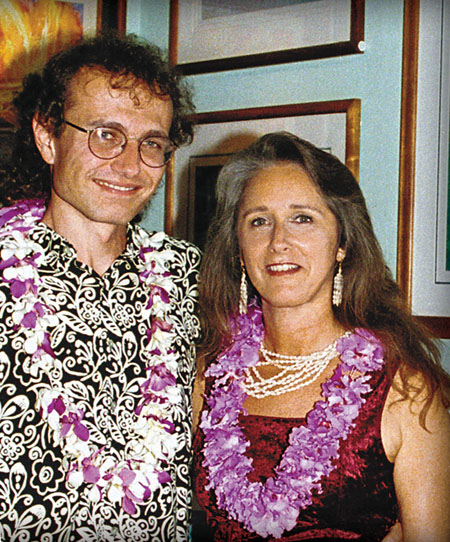
Beside Victoria at the kitchen table in their Waimea home is her husband Paul McCormick, who grew up in Alaska photographing grizzly bears and wolves. “One of the reasons we do so well together,” he says, “is because of how we are with the animals.” Victoria adds, “One time a band of Dall sheep left their lambs with Paul while they went off in search of food. It was so sweet. Animals have to be pretty comfortable to do that.”
She and Paul collaborated on a unique “Spiritual Hula” project after he moved to Hawai‘i. It portrays male and female dancers, the sacredness of the canoe and the healing power of the ocean. “We weren’t used to working with people, being wildlife photographers,” she says. “But we were accepted amazingly well.”
“Just the energy that we had together made everyone very relaxed,” Paul adds. The harmony of their marriage and work resembles the cooperative spirit of coral reefs, where a playful synergy among different lifeforms sustains and enhances every creature’s unique gifts and mutual joy. “There’s a lot that goes on behind the scenes to get the images out into the public,” says Victoria. “You have to run your business and wear a lot of different hats. I’m fortunate that Paul is a computer wizard. I’m not like that. I’m more of a feeling person, a caretaker and educator.”
They treat the ocean and marine life, not as objects, but as participants in a glorious dance of life. Such respect for the ocean has generated responses from all over the globe. Victoria’s photos have been used in cancer therapy to aid healing visualizations and by non-profit groups and governmental organizations to support conservation efforts.
How does she both capture and liberate the majesty of nature in her photos? “Mostly it’s being open, having more of a wide angle view of nature than a narrowed down telephoto,” she says. “It’s also a feeling. Some things I’ve been led to. Other times I’ve put myself out there to see if something I wanted would come by.”
Something usually does, like the time two spotted eagle rays allowed Victoria and Paul to be near them while they mated, resulting in the breathtaking “Courtship of the Magnificent Spotted Eagle Ray.”

Hawaiians named these creatures hihimanu, meaning “magnificent,” for good reason. These elegant, beautiful fish with seven-foot wing spans can fly several feet out of the water searching for food and dive to depths up to 80 feet (24 m).“They’re truly magical,” says Victoria. The females are not monogamous to one male, but to one place, a chosen bay. She hugs the edge, swimming in graceful arcs until she is ready. “When she enters the deep,” says Victoria, “then he can ask permission to court her, to mount her, to breed her.”
The breeding only lasts a minute or less, but on the day she captured this shot, Victoria had already been in the water an hour and a half and was on land taking off her wetsuit when she saw the two eagle rays. She jumped back in the water.
“I was really excited and I thought well, this could last two minutes, but it ended up lasting more than an hour.” The female came close, looking Victoria right in the eye, a humbling experience, she says. The female ray kept coming by in her rounds, and since an adult ray can have from two to six venomous spines on its whip-like tail, this close encounter was of the dangerous kind.
“The male wasn’t sure what I was. He wasn’t sure if I was competition, a threat or what, because this is the breeding season,” she says. “So, one of the remarkable things that happened was he swam right underneath me, placing himself extremely close. I thought, well, I’ll know what he thinks of me real soon. It was so intense, so amazing just to be that close.”
The eagle rays mated several times in front of her and Paul. “And that was truly a gift. It was their mating season and they allowed Paul and me to be in their world for over an hour. I was really honored.”
Afterward, Victoria captured the “Courtship” shot: rays swimming side-by-side with their wing tips almost touching. Holding hands! Love on the high seas.
Only an artist of patient, almost mystical, skill could combine the elements of light, shadow and design into such equilibrium on the fly. “By this time I’ve been doing this for so long, I know the look I want, how the fish and the animals look good and what’s complimentary towards them.”
Such affinity has also given her cause for concern. Spotted eagle rays are considered “NT,” or near-threatened, by the International Union for Conservation of Nature (IUCN).
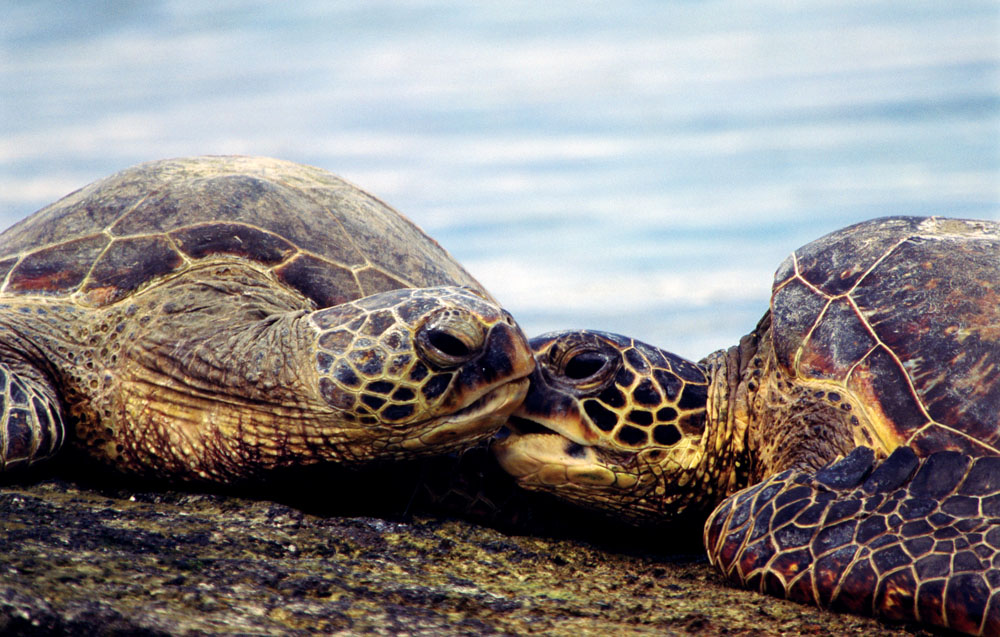
Green Sea Turtles
Revered by Hawaiians since ancient times as ‘aumakua, “guardian spirits,” honu have been swimming the oceans for millennia, living the turtle dream. Fossils 180 million years old show that Hawaiian sea turtles lived through the age of the dinosaurs and survived the age of ice.
“In the summertime when the sun is at its highest, some adult females and most of the males begin their ocean journey back to the Northwestern Hawaiian Islands’ nesting sites,” says Victoria. Some swim more than 800 miles from feeding grounds in the main Hawaiian Islands to their NHIM nesting sites.
Victoria’s photo, “The Journey Home,” considered her signature work, illustrates the awesome glory and unity of ocean, air, land and animal life.
There were once several million green sea turtles worldwide. Today, fewer than 200,000 nesting females remain. In Hawai‘i, only 100 to 350 females nest each year, predominantly at French Frigate Shoals in the Northwest Hawaiian Islands chain. The IUCN (International Union for Conservation of Nature) Red List lists all seven species of sea turtles as threatened or endangered.
While they are making a comeback, Hawai‘i’s honu are still very much in danger. Sea turtle shells are used to make jewelry, their skin to make leather goods, their meat and eggs for food and their fat for oil.
Humankind has altered the ocean through fishing, agricultural runoff and litter—including plastic bags, lighters and net debris, but the major threat to oceans is global warming. When water overheats, it bleaches algae from the electric-colored coral reefs and obliterates essential food sources for all sea life.
New thinking and new actions, though, can reverse the trend and prevent us from destroying the honu, the eagle ray, and the albatross, as well as ourselves. Our lives are deeply connected to the sea. Every time we draw a hot bath, enjoy a seascape, or snorkel in the wonderland of riches within the ocean, we take steps in this dance of life along pathways connecting the hydrodynamic commonwealth of our planet.
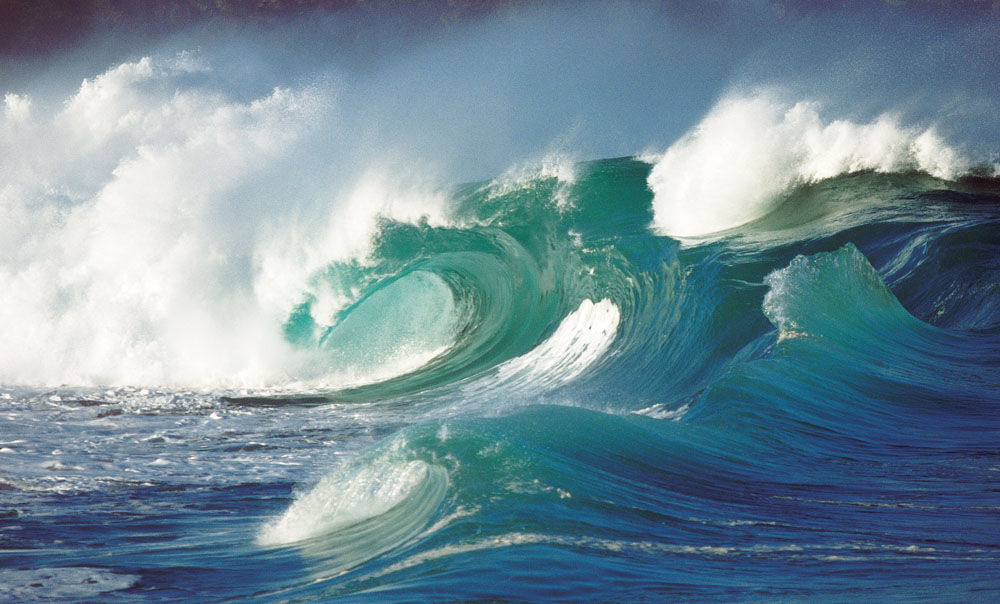
A Record of Creation
Like ancient Hawaiians who realized the ocean was a living being, home to living gods, Victoria is ardent in her conviction that marine life deserves more honor and protection.
In the second verse of the first era of the traditional Hawaiian chant of creation, He Kumulipo, the oceans are venerated as a source of health, medicine and cleansing, as well as for their economic and transportation value. This 2,012-line chant, translated by Queen Liliuokalani, marks the evolutionary progression of living creatures from heavenly light to the oceans to the land.
Like the creation chant, Victoria’s photos reveal secrets from the depths of time. With their sapphire blues, opulent teals and emerald greens of honu, monk seal, spinner dolphin and humpback whale, her images conjure the scent of salty sea air and remind us the oceans deserve our deepest reverence.
What is the song of the ocean now, we ask?
“Pay attention,” says Victoria, “I think we really need to pay attention now. The ocean is just screaming to us in some ways for help.”
And that’s really what getting the picture is all about. ❖
Protecting Our Ocean’s Reefs
How can you help when in the water or at the beach? Look but don’t touch. Stay off the bottom. Don’t litter.
Green sea turtles, monk seals, dolphins, albatross and whales are fully protected under both federal and Hawai‘i state law, prohibiting hunting, injuring or harassing them. Swimmers and divers should forget trying to play cowboy in the oceans; riding sea turtles or other marine life is illegal. It puts the animals under unnecessary stress. Fines for violating protection laws can be as high as $100,000 and may even include some time in prison.
For details on responsible wildlife viewing, reporting a beached marine mammal, stranded sea turtle or wildlife harassment, call NOAA’s Office of Law Enforcement 24-hour hotline: 800.853.1964
For more fine art photography, visit www.VictoriaMcCormick.com
To learn about the Marine National Monument, Papahanaumokuakea, visit the website www.papahanaumokuakea.gov/
Email writer Marya Mann at marya.mann@gmail.com.
